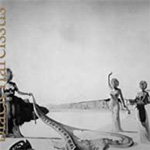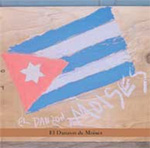| |
Three Sides Of Susie Ibarra : Songbird Suite, Black Narcissus &
El Danzon De Moises
by Derek Taylor
May 2002
To the eyes and ears of lackadaisical listeners it may seem that
Susie Ibarra's had something of a diminished profile over the last
few years. An explosive debut as a member of William Parker's Little
Huey Orchestra and later stints in the bassist's In Order to Survive
ensemble and as one fourth of the David S. Ware Quartet in the mid-Nineties
cemented her stature as a New York improviser of note and high promise.
Departure from these bands to focus on her own music and projects
contributed to an illusory sense of her leaving the loop, but the
welcome reality is that she's been as busy as ever in the interim.
Honing her own compositional skills while simultaneously forging
partnerships with the likes of Pauline Oliveros and Derek Bailey,
as well as the friends featured on this trilogy of Tzadik releases,
Ibarra continues to challenge both herself and the boundaries of
the larger musical milieu of which she remains a vibrant part.
 With
instrumentation nearly equivalent to her earlier trio with Charles
Burnham and Cooper-Moore, the opening track on Ibarra's Songbird
Suite sounds as if it could pass as an outtake from their Radiance
(Hopscotch) session. A jaunty beat born out of cantering brushes and
Jennifer Choi's coquettish streaking lines circle around Craig Taborn's
center, a mutable core that soon fragments and disperses into choppy
chords. The shift into dissonance is ever so subtle, but once the
change takes shape it yields a thrilling exchange between stabbing
keys and sawing bow. The title suite starts with an almost imperceptible
slice of electronics trailed by sobbing violin and the sporadic stutter
of metal brush on stretched skin. Distant birdsong floats at the edges
adding to the vista of ambient atmospherics. Taborn's miniature clusters
tap through the twilight forest of the violinist's somber harmonics.
The suite's final minutes are a complete contrast ablaze in furious
interplay and ferocious volume; Choi sounds as if her strings will
snap under the pulverizing pressure she applies to their surfaces.
"Trance 1" brings in a Kulintang element with segmented
arrhythmic beats and the ever friendly familiar of silence as a tension
builder. Ibarra moves over her kit using timbre and density to full
advantage with sticks and mallets. Taborn starts ominously on "Illumination",
parsing out notes as Ibarra's mallets and Choi's tearful lines follow
suit. It's an intensely lyrical piece shot through with a stratum
of distemper. With
instrumentation nearly equivalent to her earlier trio with Charles
Burnham and Cooper-Moore, the opening track on Ibarra's Songbird
Suite sounds as if it could pass as an outtake from their Radiance
(Hopscotch) session. A jaunty beat born out of cantering brushes and
Jennifer Choi's coquettish streaking lines circle around Craig Taborn's
center, a mutable core that soon fragments and disperses into choppy
chords. The shift into dissonance is ever so subtle, but once the
change takes shape it yields a thrilling exchange between stabbing
keys and sawing bow. The title suite starts with an almost imperceptible
slice of electronics trailed by sobbing violin and the sporadic stutter
of metal brush on stretched skin. Distant birdsong floats at the edges
adding to the vista of ambient atmospherics. Taborn's miniature clusters
tap through the twilight forest of the violinist's somber harmonics.
The suite's final minutes are a complete contrast ablaze in furious
interplay and ferocious volume; Choi sounds as if her strings will
snap under the pulverizing pressure she applies to their surfaces.
"Trance 1" brings in a Kulintang element with segmented
arrhythmic beats and the ever friendly familiar of silence as a tension
builder. Ibarra moves over her kit using timbre and density to full
advantage with sticks and mallets. Taborn starts ominously on "Illumination",
parsing out notes as Ibarra's mallets and Choi's tearful lines follow
suit. It's an intensely lyrical piece shot through with a stratum
of distemper.
Ikue Mori's Space Age laptop tinklings surface on "Trance No.2"
merging curiously with the acoustic acrostics of Ibarra's malleted
toms. The three transform "Flower After Flower", the titular
track from Ibarra's earlier Tzadik release, as Choi splatters florid
swatches of tonal pigment and the drummer opens up with a flood of
stick-splintering press rolls. Heavy vibrato saturates "Nocturne",
a quickly revolving piece of scurrilous concentric colloquy that soon
implodes harmonically, leaving behind a freshly birthed arena wide
open for sound. The aftermath suggests much menace and washes over
into "Trance 3", an angry cloud of industrial sounds tethered
to Choi's near static drones. "Passing Clouds" returns the
trio to the innocence of its opener, capping with a hopeful air akin
to the sun creeping from a bank of freshly depleted cumulus formations.
Taborn traipses through the sanguine chords while Ibarra stitches
the subtle, but steady beat and Choi sings a sweet lullaby of the
strings stamped with delicate pizzicato flourishes.
 Mori
is much more of a presence in the context of Mephista, a cooperative
ensemble that shares both leadership and compositional responsibilities
in equal measure. The trio's diabolical moniker translates on Black
Narcissus into music of fiendish twists and turns, often devoid
of thematic center and heavily suffused in collective improvisation.
It's a music that doggedly defies description and a dangerous place
for those reliant on the creature comforts of traditional musical
compasses like melody and harmony. Mori
is much more of a presence in the context of Mephista, a cooperative
ensemble that shares both leadership and compositional responsibilities
in equal measure. The trio's diabolical moniker translates on Black
Narcissus into music of fiendish twists and turns, often devoid
of thematic center and heavily suffused in collective improvisation.
It's a music that doggedly defies description and a dangerous place
for those reliant on the creature comforts of traditional musical
compasses like melody and harmony.
The danse macabre initiates with "The Children's Hour",
a precocious succession of darkly brooding intersections that completely
subverts the implied playfulness of its title. Electro-acoustic to
the degree that the two halves are sometimes indistinguishable, the
trio forms soundscapes that are sometimes pointillistic, other times
bludgeoningly conspicuous. On the title track, piano entrails, gurgling
diode electronics and off-kilter cymbals combine in an ominum-gatherum
of odd bits and found sounds. A linear trajectory lies submerged just
beneath the surface-seeming sonic detritus, audible, but only to the
carefully sifting ear.
Percussion and, more explicitly, rhythm forms an important crux
of the triangle's travels. Mori, herself a former drummer, deploys
a battery of abstracted loops, blips and Doppler shifts from her
various apparatuses and her role as chief texturalist makes it at
times difficult to dissect her contributions from those of her partners.
Her cybernetic enhancements of Ibarra's already formidable traps
play on "Cabbalussa" offer one of many such instances
where kilowatt-charged coils caress drum-driven acoustic beats.
The riddle of sound ownership further complicates under Sylvie Courvoisier's
eagerness to incorporate parts of her piano beyond the scope of
the conventional ivories. Plucked strings and scraped surfaces serve
her fancies as often as simply hammered keys.
Pachinko-style ricochets on "Willow's Weep" project a kinetoscopic
series of percussive shifts contrasting with the later reverie that
is "Leda and the Swan". Jump-cutting to "Poison Ivy",
the piece erupts as a tangle of echo and transitory tones leaping
and receding through a circuitous maze of oblique machinations. "Black
Widow" sprawls out over a quarter of an hour and is the most
extensive example of the trio's alien aesthetic. Mapping an amazing
temporal topography of sounds both foreign and familiar, the three
fill the minutes with a full family of ill-tempered sonic creatures.
Mori pulls back on the rambunctious "Legend of Pele" allowing
Ibarra and Courvoisier a less cluttered space to communicate. Unbridled
impressionistic ingenuity comes sometimes at the expense of narrative
flow and the tracks don't always assemble into satisfying wholes.
The breadth and diversity of sounds and relationships conjured by
the three are staggering, but moments still arise when it seems more
like a tautological enterprise of noise-for-noise's sake.
 A musical
relationship with fellow percussionist/improviser/composer Roberto
Rodriguez has allowed Susie Ibarra another outlet for her creative
energies. As a member of his twelve-piece ensemble, her role in Rodriguez's
recent project for Tzadik is more peripheral, but no less essential
to the band's overall sound. Compared to Mephista's caliginous imaginings,
the world of Rodriguez's Danzon works as a tropical tonic for the
senses. El Danzon De Moises dishes up a simmering mix of Klezmerized
Latin tunes and Latinized Klezmer tunes, but instead of being derivative
or piecemeal, these tracks are both contemplative and entertaining.
Listening to these playful discourses it's easy to envision a sun-bleached
veranda at dusk where dancers couple and cavort under the emerging
canopy of starlight constellations. Rodriguez's compositions are specially
scripted to map the myriad of Afro-Cuban contingents in the Jewish
Diaspora, tracing lines through Tango, Son and Beguine forms along
the way. Jazz-based improvisation also plays a prominent part and
many of the compositions work as inviting launching pads for individual
extemporization. A musical
relationship with fellow percussionist/improviser/composer Roberto
Rodriguez has allowed Susie Ibarra another outlet for her creative
energies. As a member of his twelve-piece ensemble, her role in Rodriguez's
recent project for Tzadik is more peripheral, but no less essential
to the band's overall sound. Compared to Mephista's caliginous imaginings,
the world of Rodriguez's Danzon works as a tropical tonic for the
senses. El Danzon De Moises dishes up a simmering mix of Klezmerized
Latin tunes and Latinized Klezmer tunes, but instead of being derivative
or piecemeal, these tracks are both contemplative and entertaining.
Listening to these playful discourses it's easy to envision a sun-bleached
veranda at dusk where dancers couple and cavort under the emerging
canopy of starlight constellations. Rodriguez's compositions are specially
scripted to map the myriad of Afro-Cuban contingents in the Jewish
Diaspora, tracing lines through Tango, Son and Beguine forms along
the way. Jazz-based improvisation also plays a prominent part and
many of the compositions work as inviting launching pads for individual
extemporization.
The band supports significant girth in its plethora of instruments,
but the leader's arrangements effectively dispel any cumbersome
qualities, fitting the components together in combinations that
emphasize harmonic space and melodic momentum. Strings and percussion
regularly stoke the ensemble's engines, but Rodriguez steers clear
of strict regimentation and players have the space to move about
freely. In tandem, he and Ibarra knit a luxurious patchwork from
trap kit and hand drums of various shapes, sizes and sonorities.
"El Polaco" serves as a sort of salutatory introduction
for the band's primary soloists. Ted Reichman, David Krakauer and
Marcus Rojas each take terse, but superior turns over an onionskin
rhythm borne on lilting syncopated percussion. Integral to "Danzonette
Hebreo" is Mark Feldman's fluid violin and Jane Scarpantoni's
somber cello, a minuet between the strings framed by the cadential
stick work of the drummers.
Mystery and humor converge on "Guahira", an old favorite
of the Carlos Santana group, as the members of the band give a collective
shout of the title invocation during the breaks. "Shron"
hints at less ebullient emotions voiced through the sustained throb
of Reichman's squeezebox and the keening cry of clarinets. The title
track spools out as a layered census of confluent voicings, Rojas'
brass and Brad Jones' chugging alongside the drummers as reeds and
strings sail above. "Jerusalem Market" stands out with a
field recording-like coarseness to the fidelity that fits beautifully
with the bustling syncopated beats that are front and center alongside
the wailing horn soloists. Sampled crowd noises and a Spanish-speaking
megaphone announcer intersperse, creating the illusion of street band
feel. This is music that stimulates both the senses and the intellect.
Rodriguez and his band of talented peers achieve a successful synthesis
of cultural capital from a variety of sources that never stumbles
under the multiplicity of its origins. Best of all, they have a
swell time doing it and it's an infectious sensation that feeds
directly into listeners' ears, not to mention feet. Suffice it to
say that with these three releases Ibarra has been keeping numerous
pots simmering over an open flame. Thankfully these three offerings
are only the beginning. The drummer everyone loves to love has much
more in store.
|
|
|
|
|

